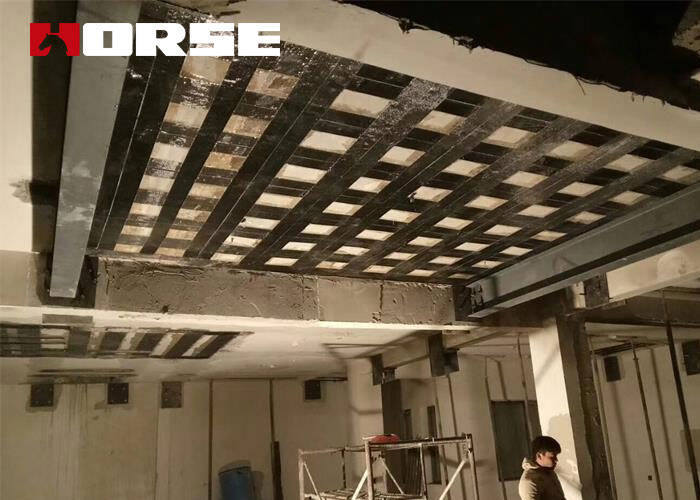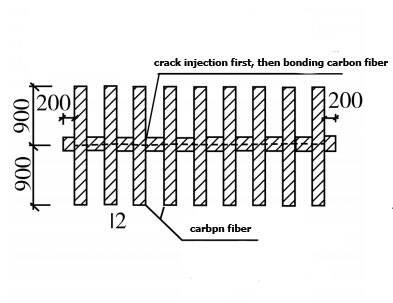Basement Structure
Carbon Fiber
By using carbon fiber to strengthen the cracks of the basement walls, beams and slabs, the mechanical performance of the structure is improved, and the bearing capacity of the structure is enhanced.

Project
The basement of a building has 2 floors for garages, the main building has 14 floors for residential buildings, and the podium building has 1 storey. After the construction of the negative two-story roof of the basement was completed, the project was suspended due to various reasons. During the shutdown period, the lack of maintenance of the foundation pit dewatering caused the groundwater level to gradually rise, and finally crossed the negative two-story roof that has been completed. The structure submerged in water is subject to the effects of groundwater corrosion, soaking and groundwater buoyancy, resulting in cracks in some beams, slabs and walls, and corrosion of concrete carbonized steel bars.
Component damage
1) Wall. Part of the shear wall has vertical long cracks, and both sides of the wall are cracked. The on-site inspection crack width is 0~0.2mm in 5 places and 0.2~0.4mm in 16 places. The on-site inspection crack width does not exceed the specification limit.
2) Beam. There were 30 rust marks in the stirrup position at the bottom of the beam, 11 cracks in the stirrup direction appeared on both sides of the beam, 8 oblique cracks appeared on the side and bottom of the beam end, the crack width was 0.2mm, and the steel bar was corroded.
3) Floor slab. There are 14 irregular cracks in the cast-in-situ slab with a crack width of 0.2mm. Obvious water marks can be seen in the cracks on site, and most of the slab bottom has rust marks along the direction of the reinforced steel bars.
4) Column. Except for two frame columns with corrosion of steel bars, no cracks and other abnormalities were found in the other frame columns under inspection.
Carbon fiber cloth reinforcement
1 Construction process
①Clean up; ②Repair the original structure; ③Interface treatment; ④Brush primer; ⑤Repair, level, brush, paste fiber materials and maintain; ⑥Construction quality inspection; ⑦Construction of protective surface layer.
2 Technical requirements for carbon fiber cloth reinforcement
1) After repairing, the concrete reinforcement and pasting part that exposes the new surface of the aggregate should be further repaired and leveled. And use structural repair glue to repair and restore defects such as large holes, concave surfaces, and exposed ribs. The parts with step differences and internal corners should be painted into a smooth curved surface. The edges and corners of the component section should be polished to a rounded corner with a radius of not less than 25mm. After finishing the above processing, the concrete surface should be cleaned and kept dry.
2) The surface moisture content of the concrete where the fiber material is pasted should not be greater than 4%, and should not be greater than 6%. The concrete whose moisture content exceeds the limit should be dried manually, or it should be pasted with a special structural glue for high-moisture surfaces.
3) The bonding quality between fiber composite material and concrete can be inspected by hammering method or other effective detection methods. The total effective bonding area confirmed according to the inspection results shall not be less than 95% of the total bonding area. When detecting, the pasted fiber composite material should be divided into zones, and the area of the hollow drum shall be determined area by area. If the area of a single hollow drum is less than 10000mm, the injection method is allowed to fill and repair. If the area of a single hollow drum is greater than or equal to 10000mm, it should be cut and repaired, and the same amount of fiber composite material should be re-attached. When pasting, the lap length at each end of the force direction (the direction along the grain) should not be less than 200mm. If the number of adhesive layers exceeds 3 layers, the lap length should not be less than 300mm; the lap length on each side of the non-stressed direction (cross-grain direction) can be taken as 100mm.
Crack reinforcement
1) The width is less than 0.2mm through the crack. Surface treatment of the cracks first, and then paste carbon fiber in the seam

2) The width ≥0.2mm penetrates the crack. V-groove pouring treatment should be opened on the cracks, the cracks should be filled with joints, and then the carbon fiber should be pasted on the joints

3) Non-penetrating cracks. If the crack does not penetrate the structural member, only need to do carbon fiber reinforcement treatment on the crack side.
4) The crack is filled with glue and sealed. If there is a cushion or other building surface layer on the concrete slab, the cracks should be cleaned up and re-examined. When carrying out pressure grouting to seal the cracks, the construction should be carried out according to the following requirements: ① bury the grouting nozzle; ② seal the joint to make the crack form a closed cavity; ③ seal inspection; ④ pressure grouting modified epoxy resin (the grouting pressure should be 0.2~0.4 MPa); ⑤ After grouting is finished, remove the grouting nozzle and seal with epoxy cement.
Concluding remarks
By using carbon fiber to strengthen the cracks of the basement walls, beams and slabs, the mechanical performance of the structure is improved, and the bearing capacity of the structure is enhanced. In addition, attention should be paid to the repair and sealing of cracks in the walls and slabs, so that the leakage problems of the shear walls and concrete slabs on the water-facing surface of the basement have been solved. The use of carbon fiber improves the construction speed of structural repair and reinforcement, and does not require complex construction tools and professional construction equipment. The operation is simple, the construction quality is easy to guarantee, and the structure size and self-weight are basically not increased. It can enhance the corrosion resistance and durability of the structure, improve the safety of the structure, extend the service life of the building, and can greatly reduce the cost of repair and reinforcement.